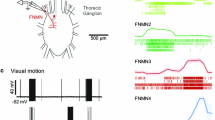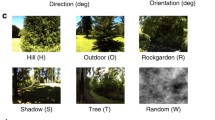Summary
Response properties of the identified H1-neurone upon monocular stimulation were investigated by means of extracellular recordings. Comparison with optomotor torque responses under the same or similar stimulus conditions demonstrated:
-
1.
The neurone is excited by regressive pattern motion and inhibited by progressive pattern motion. Vertical motion and stationary patterns induce only weak excitatory responses (Fig. 3, 8).
-
2.
If the spatial wavelength (λ) of the pattern is smaller than twice the interommatidial angleΔϕ, i.e.Δϕ<σ<2Δϕ, the response properties with regard to the direction of pattern movement are reversed: regressive motion causes aninhibition and progressive motion anexcitation (Fig. 8A). This finding accords with the concept of geometrical interference between the array of receptors and the moving striped pattern causing a reversal of the direction of movement of the interference pattern by 180 deg. As in the optomotor torque response, the geometrical interference is related to the interommatidial angle.
-
3.
The response versus pattern velocity functions possess a spatial wavelength (λ) dependent maximum as do optomotor torque responses (Fig. 8).
-
4.
The response versus pattern velocity curves share a common peak if theλ-dependence is eliminated by plotting the response versus the contrast frequency (Fig. 9). The maximum of the dependence lies atw/λ=1.4 Hz and thus agrees well with that of the optomotor torque response at 1–3 Hz (Fig. 10).
-
5.
The size and sensitivity profile of the receptive field is similar to that obtained by evaluation of the torque response.
-
6.
Statistical properties of the response under steady-state conditions show that the most frequent spike interval deviates from that corresponding to the average frequency: the lower the average frequency the larger the deviation. This finding is due to the asymmetrical distribution of the spike intervals. Of the two measures, the spike frequency corresponding to the most frequently occurring spike interval gives a better fit to the optomotor torque response.
Similar content being viewed by others
Abbreviations
- DSMD :
-
directionally selective motion detecting neurone
- imp/s :
-
impulses/s (=i/s)
- PSTH :
-
peristimulus time histogram
References
Beersma, D.G.M., Stavenga, D.G., Kuiper, J.W.: Organization of visual axes in the compound eye of the flyMusca domestica L. and behavioural consequences. J. Comp. Physiol.102, 305–320 (1975)
Bishop, L.G., Keehn, D.G.: Two types of motion sensitive neurons in the optic lobe of the fly. Nature212, 1374–1376 (1966)
Bishop, L.G., Keehn, D.G., McCann, G.D.: Studies of motion detection by interneurones of the optic lobes and brain of the flies,Calliphora phaenicia andMusca domestica. J. Neurophysiol.31, 509–525 (1968)
Buchner, E.: Elementary movement detectors in an insect visual system. Biol. Cybernetics24, 86–102 (1976)
Dvorak, D.R., Bishop, L.G., Eckert, H.E.: On the identification of movement detectors in the fly optic lobe. J. Comp. Physiol.100, 5–23 (1975b)
Eckert, H.: Optomotorische Untersuchungen am visuellen System der StubenfliegeMusca domestica L. Kybernetik14, 1–23 (1973)
Eckert, H.: Identifizierte, bewegungssensitive Interneurone als neurophysiologische Korrelate für das Bewegungssehen der Insekten. Verh. Dtsch. Zool. Ges., Hamburg, p. 86 (1976)
Eckert, H.: Identification of horizontal and vertical movement detection systems in insects. Society for Neuroscience Abstracts, 7th Annual Meeting, Anaheim (1977)
Eckert, H.: Response properties of dipteran giant visual interneurones. Nature271, 358–360 (1978)
Eckert, H.: Anatomie, Elektrophysiologie und funktionelle Bedeutung bewegungssensitiver Neurone in der Sehbahn von Dipteren. Habilitationsschrift, Ruhr-Universität Bochum (1979)
Eckert, H., Bishop, L.G.: Anatomical and physiological properties of the vertical cells in the third optic ganglion ofPhaenicia sericata (Diptera, Calliphoridae). J. Comp. Physiol.126, 57–86 (1978)
Fermi, G., Reichardt, W.: Optomotorische Reaktionen der FliegeMusca domestica. Kybernetik2, 15–28 (1963)
Fligge, B.: Neue Experimente zur Landereaktion bei Fliegen. Staatsexamensarbeit, Ruhr-Universität Bochum (1978)
Franceschini, N., Kirschfeld, K.: Etude optique in vivo des éléments photorécepteur dans l'oeil composé deDrosophila. Kybernetik8, 1–13 (1971)
Götz, K.G.: Optomotorische Untersuchungen des visuellen Systems einiger Augenmutanten der FruchtfliegeDrosophila. Kybernetik2, 22–92 (1964)
Götz, K.G.: Flight control inDrosophila by visual perception of motion. Kypernetik4, 199–208 (1968)
Götz, K.G.: Visual control of orientation patterns. In: Information processing in the visual system of arthropods. Wehner, R. (ed.), pp. 255–263. Berlin, Heidelberg, New York: Springer 1972
Hamdorf, K.: In: Praktikum der Zoophysiologie. Hanke, W., Hamdorf, K., Horn, E., Schlieper, C. (eds.). Stuttgart, New York: Gustav Fischer 1976
Hassenstein, B.: Ommatidienraster und afferente Bewegungsintegration. Z. Vergl. Physiol.33, 301–326 (1951)
Hassenstein, B., Reichardt, W.: Systemtheoretische Analyse der Zeit-, Reihenfolgen- und Vorzeichenauswertung bei der Bewegungsperzeption des RüsselkäfersChlorophanus. Z. Naturforsch.11b, 513–524 (1956)
Hausen, K.: Funktion, Struktur und Konnektivität bewegungsempfindlicher Interneurone in der Lobula Platte von Dipteren. Verh. Dtsch. Zool. Ges., Hamburg, p. 65 (1976a)
Hausen, K.: Functional characterization and anatomical identification of motion sensitive neurones in the lobula plate of the blowflyCalliphora erythrocephala. Z. Naturforsch.31c, 629–633 (1976b)
Hengstenberg, R.: Spike responses of ‘non-spiking’ visual interneurone. Nature270, 338–340 (1977)
Hertz, M.: Zur Physiologie des Formen- und Bewegungssehens. Z. Vergl. Physiol.20, 579–615 (1934)
Kirschfeld, K.: Optics of the compound eye. In: Information processing in the visual system of arthropods. Wehner, R. (ed.), pp. 61–74. Berlin, Heidelberg, New York: Springer 1972
Mastebroek, H.A.K., Zaagman, W.H. Kuiper, J.W.: Intensity and structure of visually evoked neural activity: rivals in modelling a neural system. Vision Res.17, 29–35 (1977)
McCann, G.D.: The fundamental mechanism of motion detection in the insect visual system. Kybernetik12, 64–73 (1973)
McCann, G.D., McGinitie, G.F.: Optomotor response studies of insect vision. Proc. R. Soc. Lond. (Biol.)163, 369–401 (1965)
McCann, G.D., Dill, J.C.: Fundamental properties of intensity, form and motion perception in the visual nervous systems ofCalliphora phaenicia andMusca domestica. J. Gen. Physiol.53, 385–413 (1969)
McCann, G.D., Foster, S.F.: Binocular interactions of motion detection fibers in the optic lobes of flies. Kybernetik8, 193–203 (1971)
Reichardt, W.: Detection of single quanta by the compound eye of the flyMusca. In: The functional organization of the compound eye. Bernhard, C.D. (ed.). Proceedings of the Intern. YMP held in Stockholm. Int. Symp. Ser.7, 267–289 (1965)
Reichardt, W., Poggio, T.: Visual control of orientation behaviour in the fly. Q. Rev. Biophys.9, 311–375 (1976)
Reichardt, W., Varjú, D.: Übertragungseigenschaften im Auswertesystem für das Bewegungssehen. Z. Naturforsch.14b, 674–689 (1959)
Wehrhahn, C.: Flight torque and lift responses of the housefly (Musca domestica) to a single stripe moving in different parts of the visual field. Biol. Cybernetics29, 237–247 (1978)
Zaagman, W.H., Mastebroek, H.A.K., Buyse, T., Kuiper, J.W.: Receptive field characteristics of a directionally selective movement detector in the visual system of the blowfly. J. Comp. Physiol.116, 39–50 (1977)
Author information
Authors and Affiliations
Additional information
This research was supported by grants ec 56/la+b from the “Deutsche Forschungsgemeinschaft”. Some of the pilot studies were performed at the California Institute of Technology, Department of Information Science, Pasadena, California, USA. I wish to express my gratitude to Professor G.D. McCann for his support of these investigations through grants NS 03627 and GM 15537 by the NIH, USPHS. Additional support came from grant BMS 74-21712 by the NSF to the author and L.G. Bishop.
Additional studies at the University of Southern California, Department of Biological Sciences, Los Angeles, California were supported by a salary provided by the department. I wish to thank Prof. L.G. Bishop for providing some equipment. I am indebted to Professor Dr. K. Hamdorf for fruitful discussions and to Dr. Emmerton and Dr. A. Whittle for critical reading of the manuscript. I am indebted to Dr. P. Schlecht who was most helpful in conducting some of the statistical calculations.
Rights and permissions
About this article
Cite this article
Eckert, H. Functional properties of the H1-neurone in the third optic Ganglion of the Blowfly,Phaenicia . J. Comp. Physiol. 135, 29–39 (1980). https://doi.org/10.1007/BF00660179
Accepted:
Issue Date:
DOI: https://doi.org/10.1007/BF00660179




